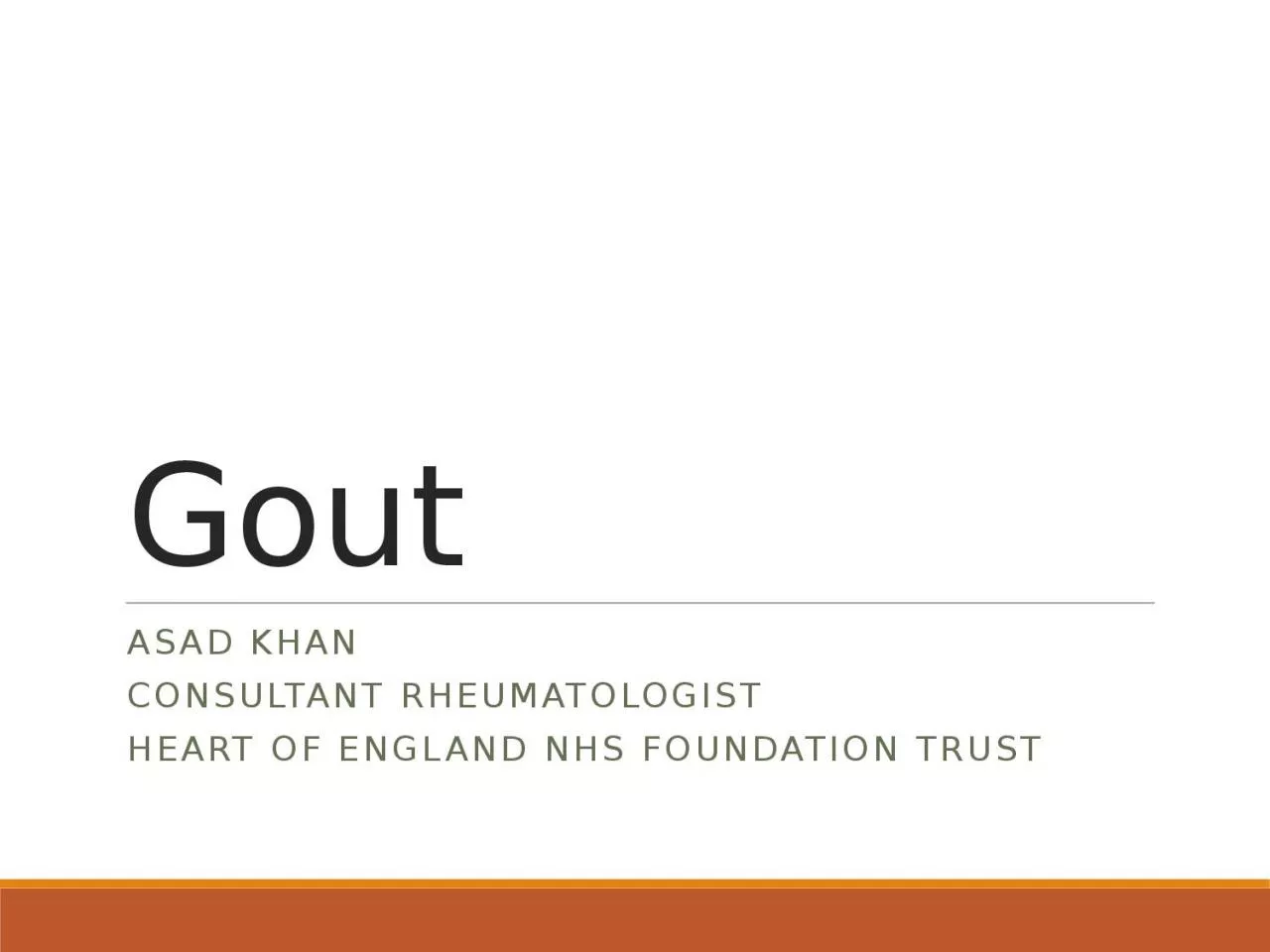

Heart of England NHS Foundation Trust Overview Background Diagnosis Risk factors Acute treatment Longterm treatment Pseudogout Gout Inflammatory arthritis due to monosodium urate crystal deposition ID: 914800
Download Presentation The PPT/PDF document "Gout Asad Khan Consultant Rheumatologist" is the property of its rightful owner. Permission is granted to download and print the materials on this web site for personal, non-commercial use only, and to display it on your personal computer provided you do not modify the materials and that you retain all copyright notices contained in the materials. By downloading content from our website, you accept the terms of this agreement.
Slide1
Gout
Asad Khan
Consultant Rheumatologist
Heart of England NHS Foundation Trust
Slide2Overview
Background
Diagnosis
Risk factors
Acute treatment
Long-term treatment
Pseudogout
Slide3Gout
Inflammatory arthritis due to monosodium urate crystal deposition
Presents with acute self-limiting attacks of severe pain
Chronic – causes
tophaceous
deposits, joint damage and chronic pain
Rising prevalence (2.49% in 2012)
Curable!
Slide4Blue: men
Red: women
Green:overall
(
Kuo
et al, Ann Rheum Dis. 2015 Apr; 74(4): 661–667.)
Slide5Purine
Uric acid
Xanthine
Hypoxanthine
Adenine
Guanosine
Inosine
Chemistry
Excretion
Deposition
Neutrophil activation
Slide6Risk factors
Male/post menopausal
Metabolic syndrome
Diet
High purine intake
Alcohol (beer/spirits)
Fructose
Drugs, including:DiureticsLow dose aspirinCiclosporin
Increased cell turnover (malignant/haematological)
Genetic predisposition/disease
Lead (saturnine gout)
Slide7Diagnosis
Gold standard
Diagnostic aspiration and polarised light microscopy
In clinical practice
Characteristic patterns of disease presentation
Can be difficult to distinguish from septic arthritis
Slide8Microscopy
Slide9Podagra
Slide10Tophi
Slide11Othe tests
Bloods
Urate in “
intercritical
” period
XRs
Punched out periarticular erosion
Ultrasound/CT?
Slide12Slide13Treating acute attacks
Full dose NSAID
Beware of comorbidities, especially renal impairment
Colchicine 500mcg 2-4 day
Adjust if low GFR
Drug interactions – including statins
Prednisolone
Non genomic vs genomic doses (30-35mg is evidence based)Intrarticular glucocorticoid injection
Combination
Slide14Purine
Uric acid
(
Allantoin
)
Xanthine
Hypoxanthine
Adenine
Guanosine
Inosine
Chemistry
Xanthine Oxidase
Uricase
Excretion
Uricosuric
Neutrophil activation
Anti IL-1
Slide15Dietary exclusion
High purine content – avoid
Oily fish, shellfish
Game
Offal
Marmite/yeast extract
Moderate purine content – in moderation
Meat/chickenBeans/legumes/peasSpinach/cauliflower/asparagus
Mushrooms
Wholegrains
Alcohol
Slide16Dietary inclusion
Low purine – fine to eat
Bread/pasta
Milk (milk protein
uricosuric
?)
Eggs
Other fruit and vegetablesButter, cheese, ice cream, chocolate, cake (beware comorbidities…)Low fat dairy and vegetable protein sourcesBlack cherry
Slide17Pharmacological treatment
Review regular medications
Treat acute attack first
Discuss urate lowering therapy at first attack, offer if >1 attack/year
Reducing uric acid can precipitate/extend attack
Prophylactic therapy along with urate lowering drug
Target uric acid <300
umol/l (or <360)
Slide18Prophylactic treatment
Up to 6 months
Low dose colchicine 500mcg once daily
Long term NSAID
IM
depomedrone
120mg
Slide19Xanthine oxidase inhibitors
Allopurinol
Start at 100mg, build up to 300mg
Up to 900mg titrated against serum uric acid
Adjust dose in CKD
Beware drug reactions (
inc
DRESS)Febuxostat80mg or 120mg
Safe in mild/moderate renal impairment
Contraindicated in ischaemic heart disease/heart failure
Slide20Uricosuric
Formulary – probenecid
Others – sulfinpyrazone, benzbromarone (latter associated with liver toxicity)
Coming soon –
lesinurad
?
Locally initiated in secondary care
Slide21Medication review
Reduce/avoid diuretics
Bumetanide?
Uricosuric
drugs
Losartan
Fenofibrate
Atorvastatin
Slide22Others
IL-1 inhibitors
Eg
Anakinra, canakinumab
Not NICE approved (anakinra not licensed)
Uricase
Pegloticase
– not NICE approvedRasburicase – to prevent tumour lysis syndrome
Slide23Uric acid and cardiovascular risk
Noted association between gout and cardiovascular disease
Is serum uric acid an independent risk factor? Trend of association with:
Hypertension
IHD/heart failure
CKD
Diabetes
Only proven associations: gout, nephrolithiasisIs low serum uric acid harmful?
Reactive oxygen species scavenger, possible association with neurodegenerative diseases
Currently – raised serum uric acid not an indication for treatment
But diagnosis of gout should prompt for assessment of cardiovascular risk
Slide24Pseudogout
Calcium pyrophosphate crystal deposition
Large joints – knee, wrist, hip
Risk factors
Age
Hyperparathyroidism
Haemochromatosis
Other calcium haemostasis disodersAcute attacks – treat as for gout
Prophylaxis – none available
Slide25(University of California, San Diego)
Slide26Summary
Commonest inflammatory arthritis
Generally diagnosed by pattern of disease rather than joint aspiration
Treatment:
Acute
Followed by urate lowering therapy
Lifestyle
PharmacologicalWith prophylaxisSee BSR (2017) and EULAR (2016) guidelines